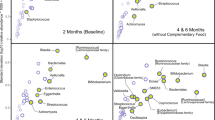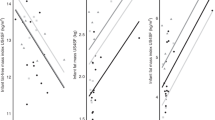Abstract
Objective:
As the antioxidant properties of human milk may be beneficial for very preterm-born infants, it is important to identify the association between total antioxidant capacity (TAC) and bio-active proteins.
Study Design:
Breast milk was prospectively collected (four times) on postpartum days 6 to 8, 13 to 15, 20 to 22 and 27 to 29 from 15 mothers who had delivered between 24 and 31 weeks of gestation. Skimmed milk was assayed to measure TAC and bio-active proteins (lysozyme, lactoferrin, leptin and adiponectin). The association between TAC and levels of bio-active proteins during the first month of lactation was analyzed in a regression model.
Result:
Coefficient of determinations (R2) revealed an overall effect of bio-active proteins on breast milk TAC (R2=0.635+/−0.102, P<0.0001). Breast milk leptin, lysozyme and lactoferrin levels were identified as independent factors that significantly predict the concentration of TAC.
Conclusion:
The identified enhancement of the antioxidant capacity of human milk by bio-active proteins that are lacking in commercial formula supports consideration of breast milk as ideal nutrition for preterm-born neonates.
This is a preview of subscription content, access via your institution
Access options
Subscribe to this journal
Receive 12 print issues and online access
$259.00 per year
only $21.58 per issue
Buy this article
- Purchase on Springer Link
- Instant access to full article PDF
Prices may be subject to local taxes which are calculated during checkout

Similar content being viewed by others
References
Robles R, Palomino N, Robles A . Oxidative stress in the neonate. Early Hum Dev 2001; 65: S75–S81.
Ochoa JJ, Ramírez-Tortosa MC, Quiles JL, Palomino N, Robles R, Mataix J et al. Oxidative stress in erythrocytes from premature and full term infants during their first 72 h of life. Free Radic Res 2003; 37: 317–322.
Dani C, Cecchi A, Bertini G . Role of oxidative stress as physiopathologic factor in the preterm infant. Minerva Pediatr 2004; 56: 381–394.
Saugstad O.D . Mechanisms of tissue injury by oxygen radicals: implications for neonatal disease. Acta Paediatr 1996; 85: 1–4.
Schock BC, Sweet DG, Halliday HL, Young IS, Ennis M . Oxidative stress in lavage fluid of preterm infants at risk of chronic lung disease. Am J Physiol Lung Cell Physiol 2001; 281: L1 386–1391.
Friel JK, Martin SM, Langdon M, Herzberg GR, Buettner GR . Milk from mothers of both premature and full-term infants provides better antioxidant protection than does infant formula. Pediatr Res 2002; 5: 612–618.
Turoli D, Testolin G, Zanini R, Bellù R . Determination of oxidative status in breast and formula milk. Acta Paediatr 2004; 93: 1569–1574.
Ledo A, Arduini A, Asensi MA, Sastre J, Escrig R, Brugada M et al. Human milk enhances antioxidant defenses against hydroxyl radical aggression in preterm infants. Am J Clin Nutr 2009; 89: 210–215.
Yao L, Friel JK, Suh M, Diehl-Jones WL . Antioxidant properties of breast milk in a novel in vitro digestion/enterocyte model. J Pediatr Gastroenterol Nutr 2010; 50: 670–676.
Uras N, Tonbul A, Karadag A, Dogan DG, Erel O, Tatli MM . Prolonged jaundice in newborns is associated with low antioxidant capacity in breast milk. Scand J Clin Lab Invest 2010; 70: 433–437.
Lugonja N, Spasić SD, Laugier O, Nikolić-Kokić A, Spasojević I, Oreščanin-Dušić Z et al. Differences in direct pharmacologic effects and antioxidative properties of mature breast milk and infant formulas. Nutrition 2013; 29: 431–435.
Tijerina-Sáenz A, Innis SM, Kitts DD . Antioxidant capacity of human milk and its association with vitamins A and E and fatty acid composition. Acta Paediatr 2009; 98: 1793–1798.
Matos K, Moutinho C, Balco V, Almeido C, Ribeiro M, Margues AF et al. Total antioxidant activity and trace elements in human milk: the first 4 months of breast-feeding. Eur Food Res Technol 2009; 230: 201–208.
Belizi S, Nazarova IA, Klimova IA, Prokof’ev VN, Pushkina NV . Antioxidant properties of lactoferrin from human milk. Bull Exp Biol Med 1999; 5: 523–525.
Park M, Youn B, Zheng XL, Wu D, Xu A, Sweeney G . Globular adiponectin, acting via AdipoR1/APPL1, protects H9c2 cells from hypoxia/reoxygenation-induced apoptosis. PLoS One 2011; 6: e19143.
Liu H, Zheng F, Cao Q, Ren B, Zhu L, Striker G et al. Amelioration of oxidant stress by the defensin lysozyme. Am J Physiol Endocrinol Metab 2006; 290: E824–E832.
Ozata M, Uckaya G, Aydin A, Isimer A, Ozdemir IC . Defective antioxidant defense system in patients with a human leptin gene mutation. Horm Metab Res 2000; 32: 269–272.
Mehta R, Petrova A . Biologically active breast milk proteins in association with very preterm delivery and stage of lactation. J Perinatol 2011; 31: 58–62.
Miller NJ, Rice-Evans C, Davies MJ, Gopinathan V, Milner A . A novel method for measuring antioxidant capacity and its application to monitoring the antioxidant status in premature neonates. Clin Sci (Lond) 1993; 84: 407–412.
Martysiak-Żurowska D, Wenta W . A comparison of ABTS and DPPH methods for assessing the total antioxidant capacity of human milk. Acta Sci Pol Technol Aliment 2012; 1: 83–89.
Berry WD, Feldman S . Multiple Regression in Practice. Sage University Paper Series on Quantitative Applications in the Social Sciences. Sage: Newbury Park, CA, 1985; 07-050, pp 15–16.
Lee JW, Davis JM . Future applications of antioxidants in premature infants. Curr Opin Pediatr 2011; 23: 161–166.
Hanna N, Ahmed K, Anwar A, Petrova A, Hiatt T, Hegyi T . Effect of storage on breast milk antioxidant activity. Arch Dis Child Fetal Neonatal Ed 2004; 89: F518–F520.
Xavier AM, Rai K, Hegde AM . Total antioxidant concentrations of breastmilk—an eye-opener to the negligent. J Health Popul Nutr 2011; 29: 605–611.
Antonopoulos AS, Lee R, Margaritis M, Antoniades C . Adiponectin as a regulator of vascular redox state: therapeutic implications. Recent Pat Cardiovasc Drug Discov 2011; 6: 78–88.
Ozarda Y, Tuncer GO, Gunes Y, Eroz E . Serum levels of leptin, adiponectin and resistin are interrelated and related to total antioxidant capacity, free fatty acids and phospholipids in early neonatal life. Clin Biochem 2012; 45: 298–302.
Savino F, Liguori SA, Petrucci E, Lupica MM, Fissore MF, Oggero R et al. Evaluation of leptin in breast milk, lactating mothers and their infants. Eur J Clin Nutr 2010; 64: 972–977.
Rocquelin G, Tapsoba S, Dop MC, Mbemba F, Traissac P, Martin-Prével Y . Lipid content and essential fatty acid (EFA) composition of mature Congolese breast milk are influenced by mothers' nutritional status: impact on infants' EFA supply. Eur J Clin Nutr 1998; 52: 164–171.
Codoñer-Franch P, Hernández-Aguilar MT, Navarro-Ruiz A, López-Jaén AB, Borja-Herrero C, Valls-Bellés V . Diet supplementation during early lactation with non-alcoholic beer increases the antioxidant properties of breastmilk and decreases the oxidative damage in breastfeeding mothers. Breastfeeding Med 2013; 8: 164–169.
Nikniaz L, Mahdavi R, Ostadrahimi A, Hejazi MA, Vatankhah AM . Effects of synbiotic supplementation on total antioxidant capacity of human breast milk. Breastfeeding Med 2013; 8: 217–222.
Acknowledgements
The authors thank all the benevolent mothers who took the time to set aside some of their own milk for research purposes, and Uday Nadgir, Nitin Goyal and Zindadil Gandhi who assisted with the sample processing and assays.
Author information
Authors and Affiliations
Corresponding author
Ethics declarations
Competing interests
The authors declare no conflict of interest.
Rights and permissions
About this article
Cite this article
Mehta, R., Petrova, A. Is variation in total antioxidant capacity of human milk associated with levels of bio-active proteins?. J Perinatol 34, 220–222 (2014). https://doi.org/10.1038/jp.2013.151
Received:
Revised:
Accepted:
Published:
Issue Date:
DOI: https://doi.org/10.1038/jp.2013.151



